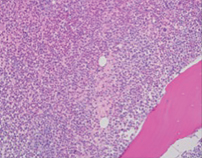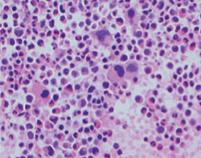The ASCO Post is pleased to present “Hematology Expert Review,” an occasional feature that includes a case report detailing a particular hematologic condition followed by questions. Answers to each question, along with expert commentary, can be found in the sidebar. In this installment, we present the case of a 46-year old man with chronic myelogenous leukemia.
Case: A 46-year-old man with diabetes mellitus, hypertension, and hyperlipidemia comes to your clinic for a second opinion. He was recently diagnosed with chronic-phase chronic myelogenous leukemia (CML). He has a history of two cardiac stents and successful cardiac ablation for supraventricular tachycardia. He has a 10 pack/year history of smoking. His local oncologist prescribed dasatinib (Sprycel, 100-mg tablets) approximately 2 weeks ago. Prior to the diagnosis, he presented to his podiatrist with a flare of gout, localized to the left big toe. The gout responded suboptimally to a course of indomethacin. Now, he has no complaints, except pain of 2 on a scale of 10, in his right big toe.
Physical examination is remarkable for palpable splenomegaly, measuring 4 cm below the left subcostal margin, with normal examination of the target gout joint. Routine complete blood cell count showed leukocytosis, with a white blood cell count of 69.84 × 109/L with predominance of neutrophils and neutrophil precursors but no basophilia and eosinophilia. His hemoglobin is 10.7 g/dL, and his hematocrit is 33%, with mean corpuscular hemoglobin of 97 fL. The platelet count is normal. The lactate dehydrogenase and uric acid levels are elevated.
The peripheral blood smear and bone marrow biopsy are shown in Fig. 1. Metaphase cytogenetics and fluorescent in situ hybridization studies are consistent with a diagnosis of CML. The reverse transcriptase polymerase chain reaction for BCR-ABL1/ABL1 is 95% on the International Scale. The calculated Sokal, Euro (Hasford), and EUTOS prognostic scores are 0.61, 26.77, and 23, respectively. The electrocardiogram demonstrates a normal heart rate and sinus rhythm, with a corrected QT interval of 499 milliseconds. He has not started dasatinib to date, as he is worried about starting a drug that he may have to take for the rest of his life for an illness that is not currently making him sick.
Question 1
In the current era of tyrosine kinase inhibitor therapy, which prognostic model is best to assess the prognosis of a person with a new diagnosis of CML?
A. Sokal
B. Euro (Hasford)
C. EUTOS
D. All of the above
Question 2
In this patient, what is the best front-line tyrosine kinase inhibitor therapy?
A. Imatinib
B. Dasatinib
C. Nilotinib
Question 3
If the patient is started on imatinib, what is the best daily dose?
A. 400 mg
B. 600 mg
C. 800 mg
Guest Editors
Syed A. Abutalib, MD, Assistant Director, Hematology & Bone Marrow Transplantation Service, Cancer Treatment Centers of America, Zion, Illinois
Jerald P. Radich, MD, Member, Clinical Research Division, Fred Hutchinson Cancer Research Center, Seattle, Washington






